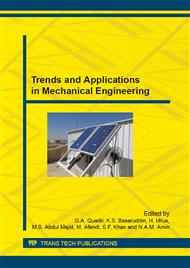p.58
p.63
p.68
p.74
p.79
p.84
p.89
p.94
p.99
Investigation of Flexure Strength on Carbon Fiber Reinforced Epoxy (CFRE) for Aircraft Panel
Abstract:
Failure behaviour of aircraft sandwich panels under bending load has been investigated in this study. Three-points bending test was performed to the specimens with various span-to-thickness (S/d) ratios 32, 40, and 60. Testing method and dimension of specimens were adhering to the American Society for Testing and Materials (ASTM) D-790M. Deflection and energy absorption of the sandwich panels was characterized by specific span-to-thickness (S/d) ratios. It was found that specimen with S/d of 40 has the steepest slope in stress-strain curve and specimen with S/d of 32 has the highest flexure strength, 831MPa. The flexure strength decreases with the increasing of span-to-thickness ratio. The result shows that the increasing of the span-to-thickness ratio increased the crack length at the lowest maximum bending stress, 636 MPa. The results suggest that the performance of the Carbon Fiber Reinforced Epoxy (CFRE) composites is strongly influenced by the crack length.
Info:
Periodical:
Pages:
79-83
Citation:
Online since:
August 2015
Price:
Сopyright:
© 2015 Trans Tech Publications Ltd. All Rights Reserved
Share:
Citation:


